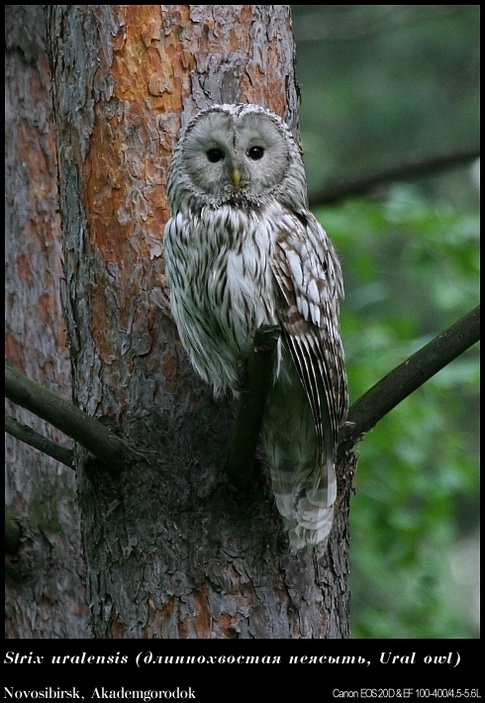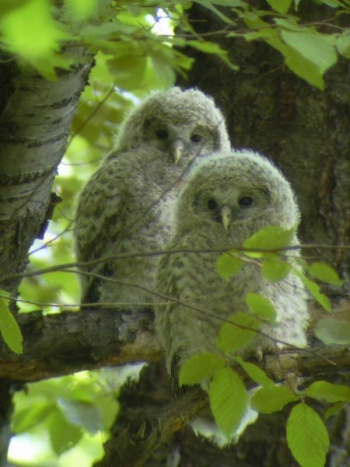(add photo of chicks, misc, taxon, refs) |
|||
| Line 1: | Line 1: | ||
| + | [[Image:2133237-SU-01.jpg|thumb|550px|right|Photo by {{user|Pasha|Pasha}}<br />Photo taken: Novosibirsk, [[Russia]].]] | ||
;[[:Category:Strix|Strix]] uralensis | ;[[:Category:Strix|Strix]] uralensis | ||
| − | |||
==Identification== | ==Identification== | ||
Male 115 cm, female 125 cm. Pale, buff grey-brown plumage, dark brown streaking on back, back of the head and underparts, round head, plain buff-grey facial disc, orange-yellow bill and small black eyes, long wedge-shaped tail, dark barring on the uppertail, rounded wings. Sexes are similar, with no seasonal variation. | Male 115 cm, female 125 cm. Pale, buff grey-brown plumage, dark brown streaking on back, back of the head and underparts, round head, plain buff-grey facial disc, orange-yellow bill and small black eyes, long wedge-shaped tail, dark barring on the uppertail, rounded wings. Sexes are similar, with no seasonal variation. | ||
==Distribution== | ==Distribution== | ||
| − | From [[Japan]] and [[Korea]] in the east to [[Scandinavia]] in the west. | + | From [[Japan]] and [[Korea]] in the east to [[Scandinavia]] and eastern central [[Europe]] in the west. |
==Taxonomy== | ==Taxonomy== | ||
| − | + | Eight subspecies are recognized. | |
| + | *''S. u. liturata'' | ||
| + | *''S. u. uralensis'' | ||
| + | *''S. u. macroura'' | ||
| + | *''S. u. yenisseensis'' | ||
| + | *''S. u. nikolskii'' | ||
| + | *''S. u. japonica'' | ||
| + | *''S. u. hondoensis'' | ||
| + | *''S. u. fuscescens'' | ||
==Habitat== | ==Habitat== | ||
| − | + | Forests with openings, ranging from mostly coniferous in the north to beach in south. Quite often in areas near birch or alder swamps. In central Europe only in mountains . | |
| + | [[Image:Ural_Owl_chicks_by_Szabi.jpg|thumb|350px|right|Newly fledged. Photo by {{user|Szabi|Szabi}}<br />Photo taken: Zemplén Hills, [[Hungary]], May 2004.]] | ||
==Behaviour== | ==Behaviour== | ||
| − | It nests in hollow tree trunks. 2-4 eggs are laid and incubated for 27-34 days. The young leave the nest after about four weeks, but will not fly until about six weeks old. | + | It nests in hollow tree trunks. 2-4 eggs are laid and incubated for 27-34 days. The young leave the nest after about four weeks, but will not fly until about six weeks old. The attending parent has been known to attack humans approaching too closely. |
| − | The diet | + | Mostly active at dawn and dusk with some activity at night; in northern areas also active at day during time of feeding of young. The diet constitutes mainly rodents, supplemented with medium-sized birds such as [[Eurasian Jay|Jay]]s, [[Hazel Grouse]], and [[Common Woodpigeon|Woodpigeon]] as needed. |
| + | |||
| + | ==References== | ||
| + | #{{Ref-Clements6thDec09}}# König, C. and F. Weick 2008. Owls of the World, second edition. Christopher Helm, London. ISBN 978-0-7136-6548-2 | ||
| + | {{ref}} | ||
==External Links== | ==External Links== | ||
{{GSearch|Strix+uralensis}} | {{GSearch|Strix+uralensis}} | ||
[[Category:Birds]][[Category:Strix]] | [[Category:Birds]][[Category:Strix]] | ||
Revision as of 21:30, 20 February 2010
- Strix uralensis
Identification
Male 115 cm, female 125 cm. Pale, buff grey-brown plumage, dark brown streaking on back, back of the head and underparts, round head, plain buff-grey facial disc, orange-yellow bill and small black eyes, long wedge-shaped tail, dark barring on the uppertail, rounded wings. Sexes are similar, with no seasonal variation.
Distribution
From Japan and Korea in the east to Scandinavia and eastern central Europe in the west.
Taxonomy
Eight subspecies are recognized.
- S. u. liturata
- S. u. uralensis
- S. u. macroura
- S. u. yenisseensis
- S. u. nikolskii
- S. u. japonica
- S. u. hondoensis
- S. u. fuscescens
Habitat
Forests with openings, ranging from mostly coniferous in the north to beach in south. Quite often in areas near birch or alder swamps. In central Europe only in mountains .
Behaviour
It nests in hollow tree trunks. 2-4 eggs are laid and incubated for 27-34 days. The young leave the nest after about four weeks, but will not fly until about six weeks old. The attending parent has been known to attack humans approaching too closely.
Mostly active at dawn and dusk with some activity at night; in northern areas also active at day during time of feeding of young. The diet constitutes mainly rodents, supplemented with medium-sized birds such as Jays, Hazel Grouse, and Woodpigeon as needed.
References
- Clements, JF. 2009. The Clements Checklist of Birds of the World. 6th ed., with updates to December 2009. Ithaca: Cornell Univ. Press. ISBN 978-0801445019.
- König, C. and F. Weick 2008. Owls of the World, second edition. Christopher Helm, London. ISBN 978-0-7136-6548-2
Recommended Citation
- BirdForum Opus contributors. (2024) Ural Owl. In: BirdForum, the forum for wild birds and birding. Retrieved 13 May 2024 from https://www.birdforum.net/opus/Ural_Owl





